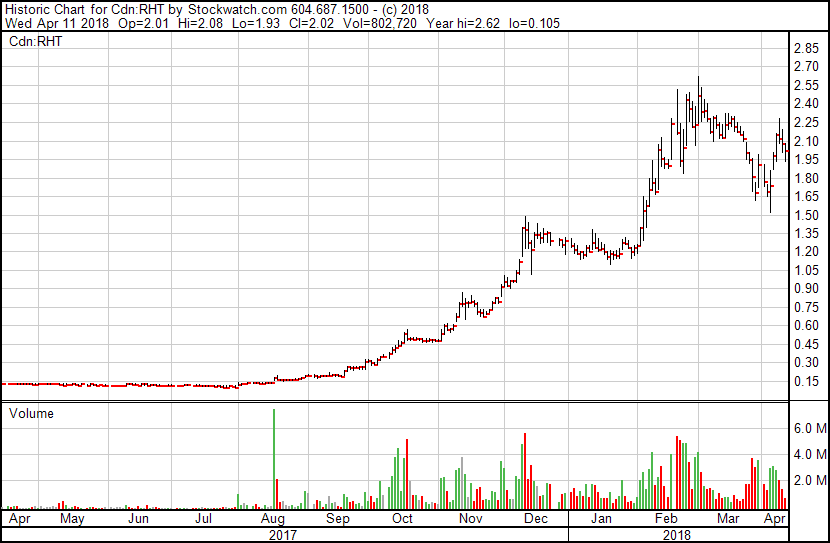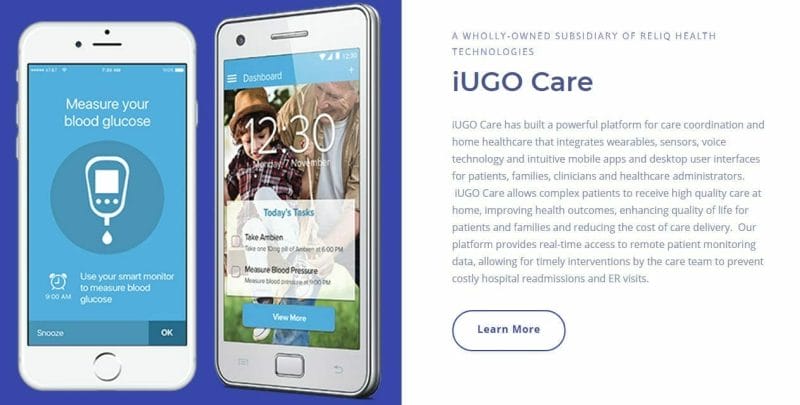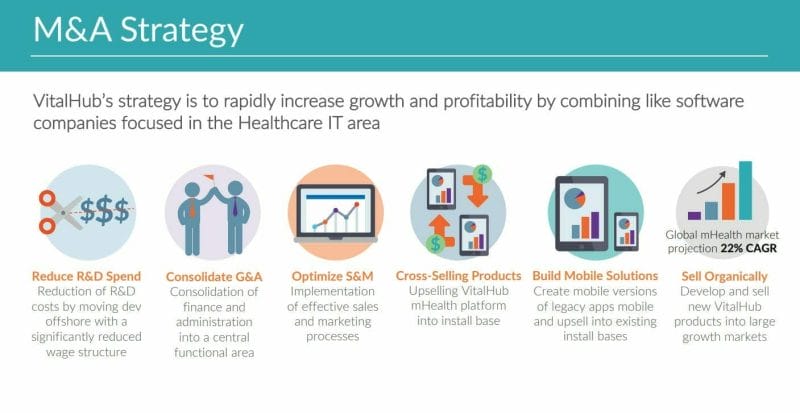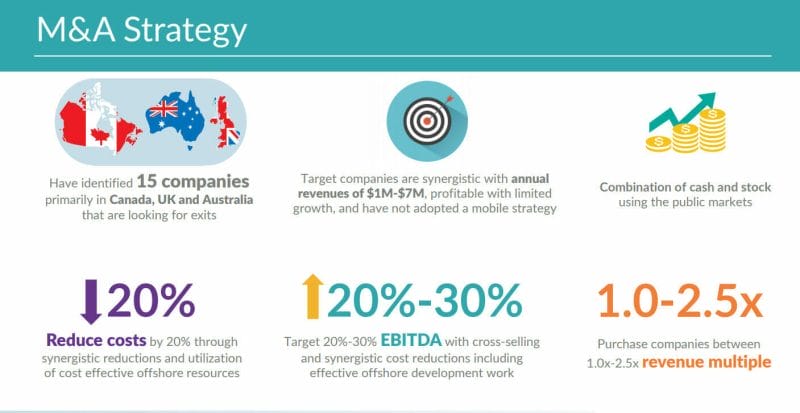About a year back, I told you guys about a telemedicine company called Reliq Health Technologies (RHT.V). You didn’t pay much attention because it was little and new and ‘telemedicine’ sounds like a Home Shopping Channel show at 2am that sells Acai supplements.
But this is what happened soon after.
A $5000 bet on the company at $0.15 a year ago would be worth $69,000 today.
To its credit, Reliq Health Technologies did the work. It said it was going to complete its technology with a view to scalability and it did. And it said it was going to run pilot programs with big health players, and it did.
And, ultimately, it said sales would come.
And they did.
But that process was not a short one. Getting under the kilt with a large provincial health care provider isn’t an easy endeavor. It’s not just about making sure the tech works. You’ve got to show you’re real, that you’ll deliver on the money spent, that end users (patients) will be helped and not hindered by what you’re doing, that their records will be kept private, and that you’re the kind of people that could stand next to a Health Minister at a photo opp without embarrassing them.
If you can do all that, then you get a pilot test. Maybe.
Reliq has successfully penetrated the health tech market, and a year later they have amassed a $208 million market cap.
This is what they’re selling:
Vitalhub (VHI.V) has a market cap of $12.4 million – roughly the same value that RHT had before it went on its run – but, unlike the path RHT had to take, Vitalhub isn’t in its ‘prove ourselves to the world‘ phase.
No, Vitalhub is deep in business already.
If these two offerings don’t look damn similar to you, you didn’t read them.
Go back and do it again. I’ll wait.
Telemedicine is what happens when doctors climb out of the 19th century and, instead of asking their patients to leave their sick beds and come into the office for an examination, they simply allow technology to take over, employing wearables, mobile phone apps, patient family members, and home-based monitors to send vital information back to the doctor, allowing her to see the vitals of many patients from her desk.
This is cheaper, faster, and allows doctor/patient contact FAR MORE OFTEN, which is important because if you’re relying on Aunt Gayle to measure her own blood glucose levels in the middle of the Young and The Restless, and then adjust her meds accordingly, she’s more likely to end up face down in a bowl of hard candy.
But if she gets a text from the doctor, noting the change in vitals with instructions to follow, or if the doc can shoot a note to a specialist informing them that Gail hasn’t moved in 32 hours… good outcomes will follow.
And for the hospitals that normally have to line up the Aunt Gayle’s and put them through expensive but not always necessary office-based tests, and can instead let those patients be tested from home, we’re talking a massive cost saving – not to mention less expense stemming from follow-up treatment when meds aren’t taken.
RHT has sold their tech to a lot of places around the US and Europe, and the revenues that brings are recurring – meaning they’re able to be counted on every month. There’s not the age old tech industry issue of, ‘we had a good January but February we’re going to need to hit the line of credit’, instead the revenues just stay level – or build as new companies sign on.
Vitalhub, as it happens, has hit the same marks. They not only have the mobile med techm they have revenues.
Arising out of a collaboration between Mount Sinai Hospital in Toronto and MaRS Innovation, the company kicked off with former management of Medworxx, after that company was acquired in a $20 million buyout by Aptean.
With cash in pocket, they acquired Vitalhub, a ‘mobile health enterprise software solutions vendor’, which had recurring revenues of $490k annually and that again in annual revenues – and $7m in development invested to that point.
Then they grabbed B Sharp Technologies in 2017, a 20-year-old Canadian electronic health records (EHR) solution and offshore med tech development team that had already earned $1.4m in recurring revenue in the health records space, and has 40 Canadian hospitals among its customers.
Then they grabbed HI Next Inc, a 19-year-old ‘web-based Electronic Health Record and care coordination platform built for health care providers,’ which has a large US install base and $2.4m in recurring revenue, not to mention over 100 tools for health care providers, and 80 behavioral health institutions as current clients.
A month later, they’d acquired Clarity Health, an Ontario-based mental health assessments unit with a startup-level $200k in recurring revs and a terrible product website.
There are two ways to penetrate the health care market as a supplier of services. First, you can go through the long term process of proving yourself, inch by inch, to any provider who’ll bless you with the right to do so for free, so that maybe one day they’ll actually do business with you.
The second way is to buy your way in – to vacuum up all those small players with interesting tech who’ve managed to get their way into six facilities here and 200 beds there, and with each purchase your pieces become larger than the sum of their parts.
NOTE: THIS METHOD HAS ENDED BADLY BEFORE.
You may recall an outfit called Concordia International (CXR.T), which blasted up the charts and into a TSX big board listing and a Nasdaq listing on the back of a strategy of buying up anything that moved in the medical tech space.
Oh, it started out nicely, with revenues coming in and profits being lodged, but a decision to borrow half a billion dollars and buy a company for several billion – surprise! – has ended up with unmanageable debt and a long tail of disappointment.
Thankfully, while Vitalhub has acquisitions in mind, it isn’t going down the Concordia road of taking out a mortgage on everything it could possibly earn, ever, to buy something that won’t cover the debt, ever.
Instead, it’s being picky. Maybe even ‘cheap’. Perhaps even vultur-ish.
The formula: Vitalhub as a core platform, B-Sharp as their offshore dev team, HINext as the first piece with existing business to plug into that system, Clarity Health as a nice little operation that can be plugged into the other pieces and upgraded, and future pickups to expand offerings, reach, and profile.
RHT has elected to do most of that work in-house, and that’s worked out okay for them, but took years to catch on. Vitalhub is finding small enterprises that are actively seeking a bigger partner to help them penetrate into the vendor space.
This is all great stuff, and with the current (low) market cap of VHI, any execution of this plan in a reasonable way should bring a nice return on value.
 A lot of companies wouldn’t leave this sort of intel just lying about for competitors to find, but the Vitalhub guys don’t feel like any old markets guy is going to be able to drink their milkshake here. They’ve been in this business for a while, and know the players well. They’re in no rush to burn through their target list and, in fact, some of those targets may get cheaper as the owner-operators get sick of butting their heads against the glass ceiling that is the medical startup world.
A lot of companies wouldn’t leave this sort of intel just lying about for competitors to find, but the Vitalhub guys don’t feel like any old markets guy is going to be able to drink their milkshake here. They’ve been in this business for a while, and know the players well. They’re in no rush to burn through their target list and, in fact, some of those targets may get cheaper as the owner-operators get sick of butting their heads against the glass ceiling that is the medical startup world.
I mean.. that Clarity Health website.. Nan and Saverio, jump on Squarespace and step it up.
Or, you know, let your new overlords at Vitalhub take care of it all, I guess.
SHARE STRUCTURE:
Not a big fan of VHI’s 124m shares out. For the uninitiated, a lot of shares outstanding (while 100m would be a lot in Canadian terms, a few billion isn’t uncommon in Australia or on the US OTC exchange) makes it harder to move the share price. VHI isn’t absurdly floppy, but if they had to use shares to buy more toys, that could happen reasonably soon.
On the upside, 38.5% of the shares are controlled by management, so they’re clearly drinking their own Kool-Aid, and 21% of the public float is held by institutions, which do a lot more intense due diligence than you or I do.
‘Good signs.’
Sorry.
There is one element of the Vitalhub strategy that I haven’t touched on yet and, while it’s a big part of their pitch, I’m going to straight up ignore it, for several reasons.
1: The market doesn’t give a shit about it right now.
2: It’s early stage.
3: The market really doesn’t give a shit about it right now.
We are, of course, talking about blockchain.
Look, if you were to ask me to rank the top three uses for blockchain tech outside of cryptocurrency – the best three ways one could make a LOAD of money using a distributed ledger – healthcare records would be number one.
The distribution, updating, availability, and security of health care records in North America is dumb, expensive, useless, slow, and costs people more than their money – it costs lives. It is the single most important thing to modernize and it’s also the last thing most hospitals, doctors, and patients put any effort into modernizing.
That’s changing. But it’s changing slowly, mostly because having access to personal health records is a major deal. You can’t let any old group of coders in Gastown get behind that curtain because the moment it’s public that Gayle has cancer, her access to employment, finance, love interests, housing, and how her family and friends will treat her becomes very different.
So allowing Gayle’s oncologist and family doctor to connect to the hospital and ensure all locations have accurate and updated (to the minute) records is important. Allowing family members to know what her treatments are, and allowing them to contribute to updated info about whether those treatments are happening is also important. Ensuring that those records have today’s information, and not just info from the last time Gayle went in for a checkup, is life changing.
But all of that has to be behind a wall so that nobody sees what they haven’t been given permission to see. Blockchain tech is a big way to make that happen, because a distributed ledger is public facing encrypted data. In essence, instead of it sitting on a server in General Hospital’s basement, it’s everywhere, waiting to be grabbed by whoever has the key – but only by those with the key.
If my health records were out there, everywhere, and every time I ran my blood sugar test it updated that record, and my doctor could check in and see it’s up and send me a note, that’s an amazing upgrading of the current system – where my doctor doesn’t know my blood sugar is up because I’m lazy and busy and enjoying that donut at the expense of my small toe.
Blockchain in health is THE place to invest in blockchain. And Vitalhub has a big strategy there that they’re already engaging in.
But the term ‘blockchain’ is sullied and broken. It doesn’t sell a stock. Until a company comes forward and says, “We have used blockchain to do a thing and we are now making money from that thing,” nobody wants to hear about it. In essence, six pages of the Vitalhub investor deck, filled with good info as they are, are wasted on this topic.
So, if you want to go see it, fill your boots. I’m not factoring it into my belief that Vitalhub is a damn fine opportunity at its current price. It may do well from blockchain, but it doesn’t need blockchain to do well.
It’s doing well already.
Vitalhub Corp. has licensed its B Care Electronic Health Record software (EHR) to Manitoba’s Northern Regional Health Authority (NRHA), to support NRHA’s child and adult inpatient and community mental health programs.
In 2013, Vitalhub’s B Care EHR platform was sold and implemented into a major Manitoba inpatient mental health facility that provides services to residents of Manitoba and Nunavut, whose challenging needs cannot be met elsewhere in the provincial health care system.
Building on the success of Vitalhub’s implementation, the NRHA has licensed the use of Vitalhub’s B Care EHR. This sale marks a significant event for Vitalhub, supporting the first implementation of an EHR, and the interRAI child and youth mental health (ChYMH) and adolescent supplement to support the provinces Healthy Child Manitoba program. This implementation will serve as a demonstration site that will be evaluated to application across the rest of the province.
It’s happening.
— Chris Parry
FULL DISCLOSURE: Vitalhub is an Equity.Guru marketing client.
https://equity.guru/2017/08/17/told-ya-reliq-health-technologies-rht-v-flies-us20m-deal/










Hi Chris, so what are your thoughts on RHT after these last few weeks of plummeting SP and the announcement yesterday?
It’s not great news, but I suspect it’s oversold. The run from $2.50 down to here has been dramatic. Company needs to do better in telling its story.